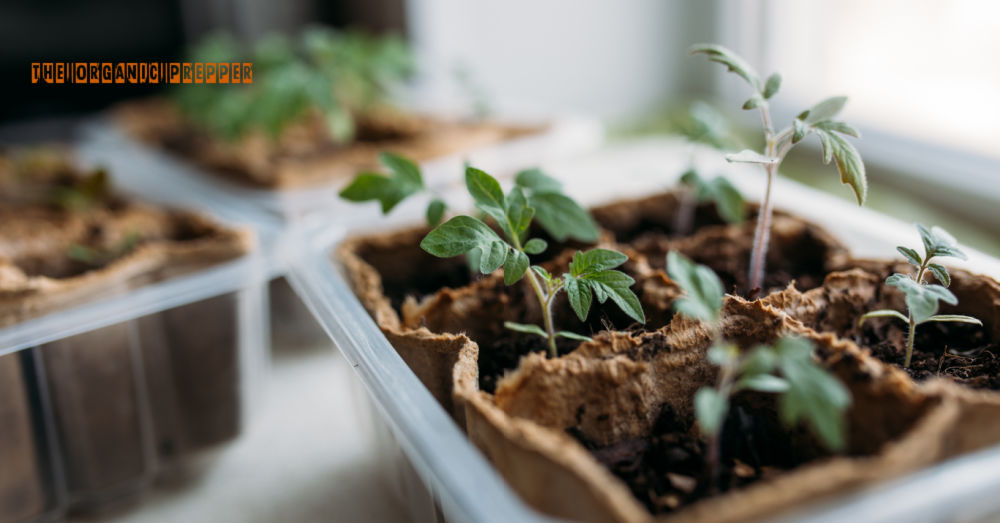If you're new here, you may want to subscribe to my RSS feed. Thanks for visiting!
So you’ve decided to start your own seedlings this year. You’ve chosen your varieties, set up your area, and planted. You’re seeing lovely green sprouts in the pots and are very excited, taking the best care of them you know how. Then one day, soon after sprout, your seedlings are lying on the potting medium. No obvious explanation, no warning. Just lying there dying. Chances are you’re experiencing damping off disease.
So what exactly is damping off disease?
According to the University of Minnesota, it’s a disease of young seedlings that’s actually pretty common and affects a wide variety of vegetables. Rhizoctonia, Fusarium, and Pythium are the most common pathogens. According to their webpage, symptoms are:
- Seedlings fail to emerge from the soil.
- Cotyledons (the first leaves produced by a seedling) and seedling stems are water-soaked, soft, mushy, and may be discolored gray to brown.
- Seedling stems become water-soaked and thin, almost thread-like, where infected.
- Young leaves wilt and turn green-gray to brown.
- Roots are absent, stunted or have grayish-brown sunken spots.
- Fluffy white cobweb-like growth on infected plant parts under high humidity.
As I’ve noted in the introduction, I’ve seen seedlings simply tip over and die. And there’s no saving them. This disease is vicious and can kill off entire trays of seedlings.
What causes damping off disease?
Damping off is a soil-borne pathogen. It moves through the soil (or potting media) while watering, which allows it to move easily from plant to plant. It can be introduced by using garden soil as potting medium, which is why commercial sterilized media can be a better option. According to UM Extension, the pathogen can be introduced in a number of ways:
- Pots, tools, and potting media that have been used in previous seasons and are not properly cleaned can harbor the pathogens.
- Spores of Fusarium spp. can be blown in and carried by insects like fungus gnats, or move in splashing irrigation water.
- Pythium spp. is often introduced on dirty hands, contaminated tools or by hose ends that have been in contact with dirt and debris.
And there is no cure once infection occurs! There’s no way to save your seedlings. Your best course of action is to start over, following good sanitation procedures to prevent the issue from occurring.
How do you prevent damping off disease?
There are several steps you can take to prevent damping off disease.
Keep it clean.
Cleanliness is your best option and will save you many problems in addition to damping off.
Clean your workspace, tools, hands, trays, and pots with a bleach solution. Some recommend letting your pots and trays sit in a 10% solution for 20-30 minutes. I simply wipe mine out, rinse thoroughly to remove bleach residues, and let them air dry. I reuse them every year. I clean my garden tools with a Chlorox (or similar) wipe after every use, and between plants if I see problems while pruning.
According to UW-Extension, a spray of 70% isopropyl will also work. They recommend not reusing plastic pots that have had this problem, as they’re difficult to disinfect. The plastic pots I reuse haven’t had this problem.
Keep it warm.
Since the pathogens thrive in cool, damp soils I like to grow my seedlings on a heat mat, at least until they pass the stage where damping off is common. Heat mats are relatively cheap and will last 3-5 years, and I’ve found them a wonderful investment. In fact, if you live in one of the colder zones as I do, they’re a must! I start my frost-sensitive plants, such as tomatoes, around April 1, or even a few weeks earlier in the case of slow-growing peppers. There’s often still snow on the ground then, and days hover around the freezing mark. Nights are colder, and seedlings won’t thrive without the heat mat.
Grow lights will also help keep the area warm and provide enough light for seedlings to grow. Simply being by a window, even a south or east-facing window, isn’t enough. Winter light is much less intense than summer due to the Earth’s rotational axis, so daylight has to be supplemented at least. My seedling rack has two T5 lights per tray, one each of cool white and purple. Photosynthesis uses the red and blue light spectra. The other colors contained within white light are a bit superfluous, at least for this purpose.
Choose your potting media carefully.
I’m not a huge fan of oven sterilization due to my experiences trying to grow mushrooms in oven-sterilized media, so I buy a commercial seed starting mix. Planet Natural suggests an organic mix. Last year I purchased one that claimed to contain both mycorrhizae and Rhizobium and had nothing but problems. I ended up doing an emergency run to the garden center because my seedlings were runted and had several other diseases, mostly leaf spots.
While it is possible to simply get a bad batch of an otherwise good mix, I suggest choosing your media carefully. A well-sterilized media will save you many problems! If you’d prefer to make your own mix, I show you how and discuss commercial options along with the qualities of a good seed-starting mix here.
Give them some air.
Air circulation will also save you many headaches, including those caused by damping off. Plant your seeds and thin them out well so they’re not crowded in the tray. A small fan will not only keep the air moving, it’ll help strengthen stems as your seedlings grow. If you use germination trays with a humidity dome, simply cracking the lid can suffice.
I remove the plastic from my pots once I see seedling emerge. As the weather warms, I open my grow room windows for an hour or so per day. Later as I’m hardening them out, I leave them on my deck so they get both air circulation and any rainwater that comes by. I leave them in my greenhouse overnight to avoid low night temperatures and rodent predation. My deck is 12’ above the street. Squirrels don’t have a problem getting up there. Protection for the plants by night, air circulation by day.
Water judiciously.
When my seedlings are young, I give just a little water several times per day because the new roots are tiny and water quickly passes them by. As they grow older, I give more water but only 1-3x per day, until I’m watering only once per day. Remember: disease pathogens thrive in cool, moist soils. Roots can also rot under such conditions. Good root development will help immensely at transplant time, giving your seedlings the ability to settle in and grow well right from the start.
Commercial seed starting media do tend to be water-retentive so I suggest paying good attention to this area. If you’ve got mold or mushrooms growing out of your media, repot into clean pots. Done this, been there. While runts will usually recover and grow quite nicely, diseased runts will not. And don’t depend on what the soil looks like on top. Lift the pot and/or dig down a bit with your finger. Heavy pots and fingers that come up with soil attached don’t need watering.
Have you ever had this issue?
Are you looking for more information about growing food this year? If so, don’t miss our Home Agriculture Comprehensive course.
Have you experienced damping off disease or other problems when starting seedlings? Do you have any tips to prevent these issues? Let’s talk about it in the comments section.
About Amy Allen
Amy Allen is a professional bookworm and student of Life, the Universe, and Everything. She’s also a Master Gardener with a BS in biology and has been growing food on her small urban lot since 2010.

















8 Responses
This was super helpful info! My seedlings are growing as we speak. Thanks Amy.
You’re welcome Sweetie! Good luck with your garden.
Just in time. I’ve been studying for weeks about how to start my veggie raised beds. I was going to mention that I’ve read, they recommend watering the trays underneath the cells where the seeds are planted to avoid rot. They will pull the water as needed without drowning. Also, using an oscillating fan to mimic the breezes they will experience outside helps to prevent them from becoming ‘leggy’ & weak.
Thank you Amy!
You’re welcome! I’m glad I could help. I’ve known many gardeners who use a small fan to mimic a breeze. This strengthens the stems very well. Regarding watering from the bottom, I caution you on that one. Remember: the seeds and tiny seedlings are up in the top of your pot, not too far from the surface. Watering from the bottom means the water has to move upwards by capillary action, and this will leave the soil moist all of the time. Venus flytraps and mangrove swamps like this, veggies really don’t. It’s better if the soil has a wet/dry cycle. Constantly moist conditions can cause a number of problems, including root rot and damping off. That’s why I water mine from the top using a small bottle with a rain nozzle. The water comes down gently, moves by the developing roots, and away.
Gotcha thanks.
I’m not the green thumb in our family, my wife is. I could kill weeds if I tried to grow them, LOL.
I showed the article to her, and she said it’s not something she’s ever had a problem with.
She builds her own potting mix, that’s worked very well for her seedlings. A large component of her mix is from our compost, and I know that our pit can reach temps over 130° F. Perhaps that’s one reason it hasn’t been a problem as many of the soil borne pathogens don’t tolerate temperatures that high.
We also live in an arid climate, and that may be a contributing factor as well.
Lucky you! Keep up the good work! 🙂
Water every third watering or so with some strong Chamomile tea you can make cheaply at home. Let it cool and apply – its a natural anti-fungal. We’ve used that technique for decades if we ever had a problem. Using heat mats and clean containers and soil really helps in the first place.